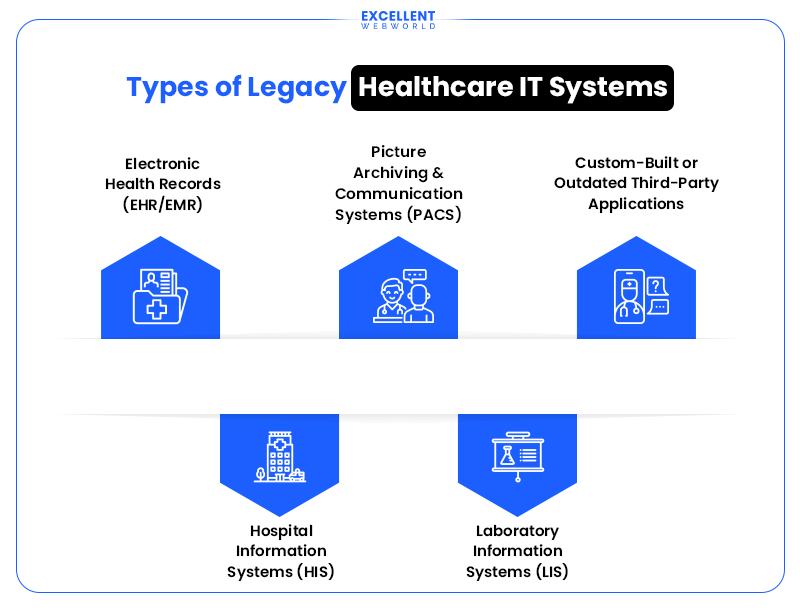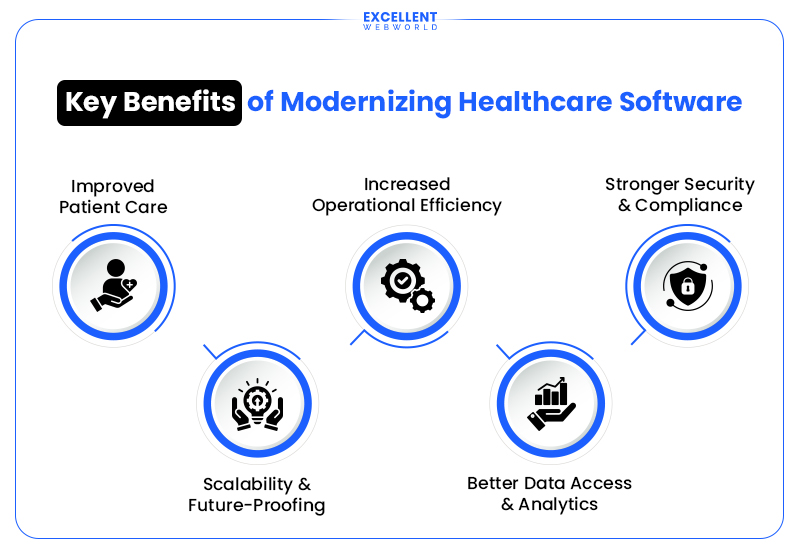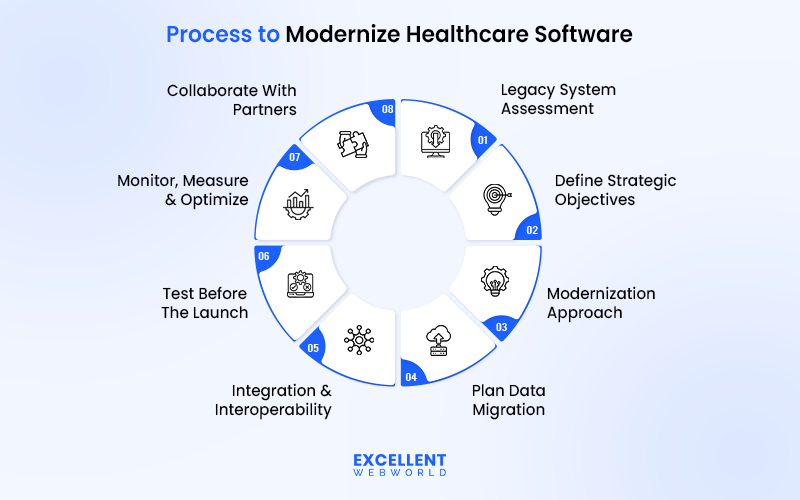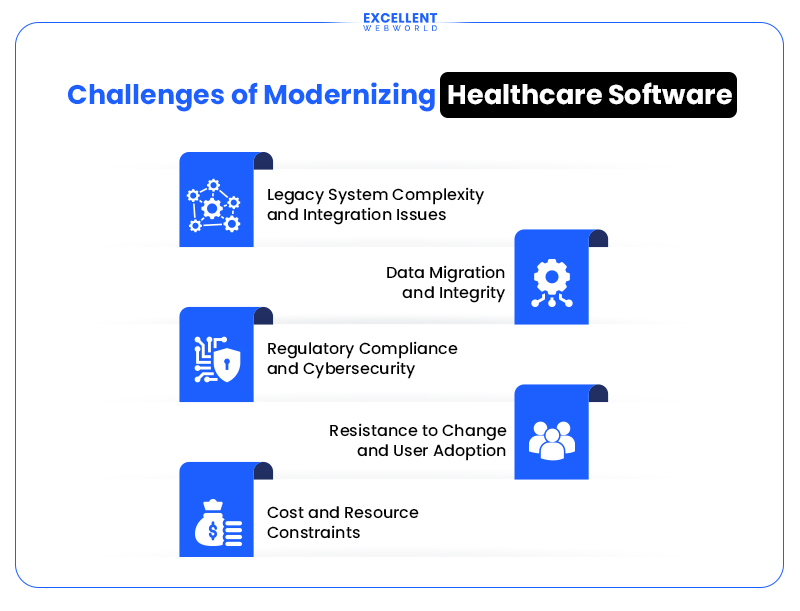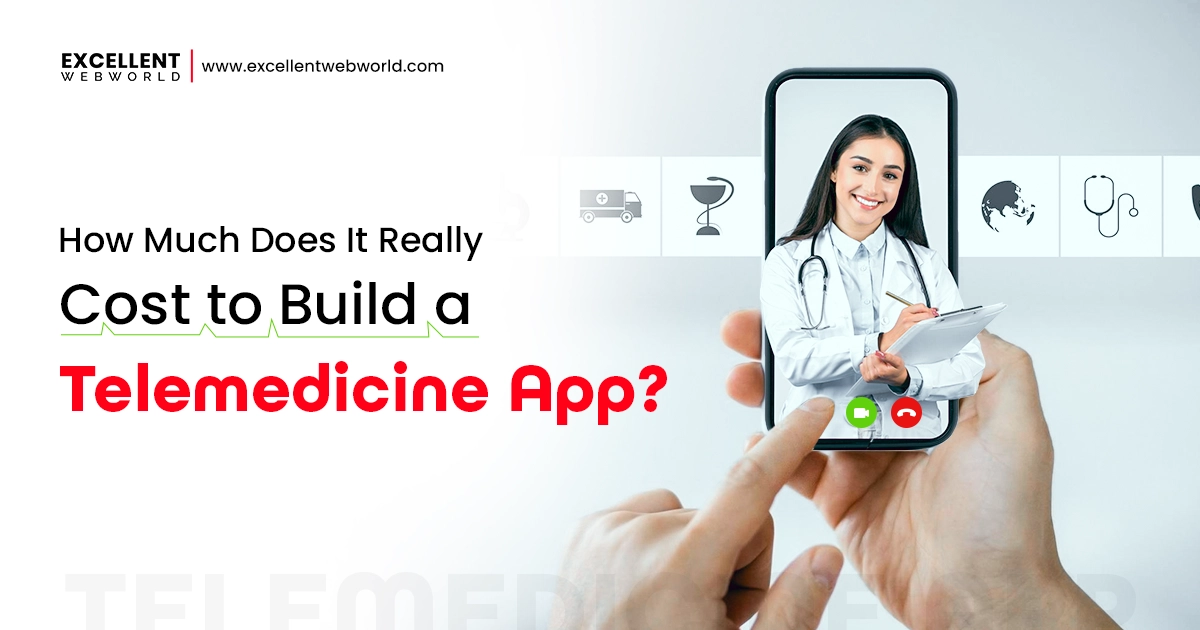Is your healthcare system slow when patient count increases?
Is your administrative overhead eating up your revenues?
Then it’s time to modernize your legacy healthcare systems.
Most legacy software lacks interoperability, security updates, and integration capabilities. This has led many clinicians, hospital chains, and CTOs of healthtech firms to modernize their software.
Take, for example, the Mayo Clinic’s legacy pathology system, which became slow over time in disease detection. Mayo Clinic partnered with NVIDIA for healthcare software modernization to add AI-driven diagnostics. This helped them improve the accuracy of disease detection across 10 million patients.
In the AI era, modernizing healthcare software is more important than ever to ensure smarter patient care.
However, if you are new at this, this guide provides everything you need for your healthcare software modernization, like,
It offers a complete blueprint whether you are planning to modernize EHR systems, lab systems, or administrative healthcare software.
What is Healthcare Software Modernization?
Healthcare software modernization is a process of upgrading the existing system to improve performance, security, and user experience. It includes cloud migrations, interoperability improvements, and integration of the latest innovations, such as AI.
What is a Legacy System in Healthcare?
A legacy system in healthcare refers to outdated software that fails to meet the needs of modern clinical operations. For instance, legacy radiology software becomes a bottleneck for modern clinical workflows due to its lack of customization. Furthermore, this software lacks interoperability, and security updates can lead to cybersecurity breaches.
Why Are Legacy Systems in Healthcare Still Used?
Hospital chains and private clinics avoid modernizing healthcare software because their workflow structures have become very integrated. This is why some legacy healthcare systems are still used despite being outdated.
Despite their limitations, many legacy systems in healthcare remain in use because of:
Healthcare IT modernization can help reduce risks and costs and maintain compliance. However, you need a well-planned healthcare software modernization to ensure operational efficiency at optimal costs. This is why consulting with a project management consultant is crucial to strategize your budget, IT infrastructure, and migrations to reduce risks.
Pro Tip: Begin with a phased modernization approach before committing to a complete rebuild. Understand the existing legacy systems first, identify the ones that require modernization, and then plan accordingly.
Before upgrading your healthcare software, it’s essential to identify which systems need modernization and why. Let’s examine the types of legacy IT systems that are most critical to update.
What Are The Types of Legacy Healthcare IT Systems?
Legacy healthcare IT systems consist of outdated software and hardware technologies used in hospitals, clinics, and other healthcare facilities. These systems can be classified into several categories, including electronic health records (EHR), hospital information systems (HIS), laboratory information systems (LIS), and picture archiving and communication systems (PACS)
Before you plan for healthcare software modernization, you need to identify the types of legacy systems that need an upgrade. For example, if your billing system is outdated and does not comply with medical codes, it requires an upgrade. You can build medical billing software using the latest medical codes and replace it to modernize health insurance claim management and billing systems.
Here are some legacy system examples you need to know,
1. Electronic Health Records (EHR/EMR)
EHRs are key to patient data management. Legacy EHR systems are not interoperable and have issues meeting modern data sharing standards like FHIR and HL7. Also, there are compliance issues when using legacy systems. Regulations like HIPAA and GDPR have specific data management standards that need modern healthcare systems
Need of the hour-
Plan EHR modernization according to the patient outcomes, compliance, and operational efficiency. It will help you upgrade the legacy system without compromising on ROI.
2. Hospital Information Systems (HIS)
Hospital administration needs software that can centralize information. HIS does that, but with modern operations and hospital administration challenges, such systems are becoming outdated. It does not offer support for real-time data access, and compatibility with mobile devices is also a challenge.
Need of the hour-
Upgrade your HIS systems with scalable healthcare software modernization solutions. Ensure you plan the data migration in healthcare systems to reduce information leakages during the transition phase.
3. Picture Archiving and Communication Systems (PACS)
PACS platforms have integration issues with modern systems. Such outdated systems often have slow image retrieval times and offer minimal support for AI-driven diagnostics. This can be an emergency where diagnosis depends on image retrieval and analysis.
Need of the hour-
Shift your PACS to cloud-based platforms that offer faster image retrieval. Using cloud computing in your healthcare process will enable diagnostic accuracy and streamlined workflows.
4. Laboratory Information Systems (LIS)
Legacy LIS platforms lack modern features and integrations, leading to slower lab results. EHR integrations are also a significant challenge due to outdated APIs and security issues. Without outdated LIS systems, patient data is siloed, leading to duplicate data entries and poor information exchange across departments.
Need of the hour-
Upgrade your LIS to improve data accuracy and workflow efficiency while ensuring smooth integration with EHR systems.
5. Custom-Built or Outdated Third-Party Applications
Custom healthcare apps offer many benefits to your operations, like specific functionalities based on location, patients, and operations. However, these apps can become outdated if you don’t update them with modern features. Such systems can have security issues due to irregular updates and old APIs that do not allow new integrations.
Need of the hour-
Assess and replace unsupported applications with modern, secure software to protect your healthcare IT infrastructure and ensure compliance.
Understanding the legacy system examples is crucial to your modernization plan. But why should you consider investing in healthcare software modernization now? Let’s understand!
Why Consider Healthcare Software Modernization?
Healthcare software modernization offers several benefits worth investing in for your clinical practice. Whether it’s integrating modern features of telemedicine apps or modern healthcare technology like AI, you need a modern IT infrastructure.
Everyone talks about physician compensation.
Almost no one talks about overhead.We debate how much CMS pays.
Why procedural specialties are paid more.
How physicians are reimbursed.But that misses the real driver of dysfunction:
The single most expensive, least addressed… pic.twitter.com/ZkaGUjS2t5— John Asghar MD (@JahangirAsgha10) May 27, 2025
Legacy healthcare systems have led to increased overhead costs, which consume 60-70% of clinical practice revenues. This is primarily due to modernization, EHR requirements, and increased administrative costs. However, this is not all, and other key considerations are,
1. Inefficiencies and Risks of Legacy Systems
Legacy healthcare IT systems are fragmented, complex to scale, and challenging to maintain. They can also expose your organization to serious cybersecurity threats due to outdated protocols. Such systems often have outdated encryption algorithms or security mechanisms that cause issues with HIPAA compliance.
Modernization Impact:
Modernization can improve compliance in healthcare software. Building a HIPAA-compliant system for your clinic can ensure better data security and patient trust.
2. Regulatory Pressures and Compliance Requirements
Legacy systems in healthcare industry often have older security patches. Plus, a lack of security measures like multi-factor authentication can lead to the risk of patient data breaches and compliance issues.
Plus, the guidelines of maintaining compliance with HIPAA, GDPR, and other regulations keep evolving. Keeping up with these changes is challenging for software that does not receive regular security updates.
Modernization Impact:
EHR modernization helps healthcare providers comply with these regulations. With better data governance and built-in compliance support, the modernizations of healthcare software ensure compliance.
3. Better Patient Care and Data Accessibility
Outdated healthcare systems make it difficult for clinicians to deliver timely, personalized care. Delays in accessing electronic health records, lab reports, and diagnostic images can compromise treatment outcomes. Longer patient queues lead to delayed procedures and increased workloads.
Modernization Impact:
Modernization of healthcare software enables real-time access to patient data. These systems improve clinical accuracy by adding AI capabilities to mobile healthcare apps and IoT-integrated systems.
4. Operational Agility and Scalability
As healthcare providers scale their services, legacy infrastructure quickly becomes a bottleneck. These rigid systems are costly to scale and often incompatible with emerging solutions like telemedicine apps, remote patient monitoring, or AI integrations.
Modernization Impact:
Cloud-based healthcare IT systems provide flexibility for scaling operations and adopting innovations more quickly. You can leverage a telemedicine app development company to create scalable cloud-based solutions with virtual health consulting capabilities.
5. Digital Transformation and Competitive Pressure
With a push for healthcare software modernization, there is immense pressure to execute digital transformations quickly for your organization. Plus, matching the competition and patient expectations for successful digital transformation in healthcare systems is challenging.
Modernization Impact:
Modernizing your healthcare software infrastructure keeps you ahead of patient expectations and strengthens your market position. Healthcare digital transformation can help you ensure integration of modern innovations and digitize operations to gain a competitive edge. Here is a comprehensive resource on how digital transformation is reshaping the healthcare industry.
6. High Maintenance Costs And Resource Drain
Maintaining legacy healthcare software can be costly due to the expenses of repairs, updates, and specific technology upgrades. You also need to consider the licensing costs of software. These costs divert the funds you need to allocate for patient care improvements and modernization efforts.
Modernization Impact:
Healthcare legacy application modernization can help you avoid maintenance costs by providing regular updates and using the latest technologies.
Knowing the benefits of modernizing healthcare software is essential before deciding whether to do so. It will help you understand the value that your healthcare organization can get from the modernization process.
What Are The Benefits of Healthcare Software Modernization?
Healthcare software modernization provides numerous advantages, such as increased efficiency, improved patient experience, better data management, cost reductions, and enhanced security. These are some of the key benefits of custom software development in the healthcare sector. In addition, it improves interoperability.
Other key benefits are,
The decision to opt for healthcare software modernization requires all stakeholders to be on board. So who are they, and what’s their role? Let’s understand them.
Which Stakeholder Groups Should You Involve for a Comprehensive Healthcare Software Modernization Plan?
Successful healthcare software modernization requires input from all key stakeholders to ensure clinical relevance, technical viability, regulatory compliance, and user adoption.
Now that the stakeholders are onboard, it’s time to modernize the healthcare software. However, it’s not a straightforward process and has many phases. Let’s break down the key steps in modernizing healthcare software.
What Are The Key Steps In The Healthcare Software Modernization Process?
Healthcare software modernization involves updating or replacing outdated systems to enhance performance, security, and user experience. This process includes evaluating existing systems, setting clear goals, selecting the right technology, and implementing phase changes.
Here are the key phases of the healthcare software modernization process.
1. Legacy System Assessment and Planning
Assess the existing software, hardware, and infrastructure to identify areas for improvement. Audit all the compliance records, the need for integrations, and performance bottlenecks. You must also assess the technical debt and engage clinical and administrative stakeholders to understand the system’s limitations.
Based on the assessment plan for your healthcare software modernization requirements, like,
Pro Tip :
Use data from recent compliance audits and EHR usability feedback to prioritize which legacy applications to evaluate first.
2. Define Strategic Objectives
Set modernization goals that are measurable and align with your overall objectives, such as enhanced data security, reduced costs, or improved patient care. You can use the SMART approach to define goals by consulting with business IT consultants. For example, if you are aiming to leverage cloud migration for healthcare modernizations, here is how you can define goals
Pro Tip:
Define your objectives with measurable KPIs, such as “reduce insurance claims rejections by 40%” or “cut patient data infrastructure costs by 35% through cloud migration.”
3. Choose the Right Modernization Approach
Choose a suitable healthcare software modernization approach based on your objectives and the modernization roadmap. Some of the methods that you can select are,
Pro Tip:
Use a cost-benefit matrix to evaluate each modernization approach and implement the most suitable option.
4. Plan Secure Data Migration
Move data in phases to avoid disruption. Begin with non-critical systems and implement automated validation tools for accuracy. Secure the process with role-based access and encryption. Deploy data recovery mechanisms to ensure there is no data loss.
Pro Tip:
Cleanse and standardize legacy data before healthcare system migration to improve downstream analytics and AI adoption.
5. Enable Integration And Interoperability
Deploy middleware and APIs to connect new systems with legacy tools and external platforms. Integrate AI into your healthcare systems to enable advanced features like predictive analytics, diagnostics, and personalized care.
Integrating predictive capabilities requires a strategic solution that aligns your healthcare goals with advanced features. This is where you can leverage an experienced AI development company to create customized integrations for your healthcare software.
Pro Tip:
Use API gateways and cloud data lakes to simplify future integration with mobile apps and IoT devices.
6. Test Rigorously Before The Launch
Conduct full-cycle testing for performance, security, and data integrity. Simulate real clinical scenarios to catch issues early and avoid disruptions during high patient load periods. Plus, you can use unit integration and user acceptance testing to adjust the system based on test results.
Pro Tip:
Run parallel systems during testing to compare outputs and ensure data consistency.
7. Monitor, Measure, And Optimize
Track system performance after healthcare software modernizations using pre-defined KPIs such as patient wait times, system uptime, data security, and ROI. Use these insights to adjust system configurations and ensure continuous improvements.
Pro Tip:
Make sure you have regular system performance audits to check for issues due to scale, data overload, or infrastructure bottlenecks.
8. Collaborate With Technology Partners
Healthcare IT modernizations require a phased process with multiple aspects, including technical implementations and strategic planning. This is why partnering with an experienced healthcare app development company is crucial. They can help you leverage best practices, ensure compliance, and integrate the latest innovations, like AI, into healthcare software.
Pro Tip:
Before partnering with any software modernization partner for your healthcare service, check their past work and domain expertise.
Implementing these steps requires a planned approach. Without strategic implementation, healthcare software modernization may not produce the expected outcome. This is also important to overcome any challenges during the implementation.
What are the Biggest Challenges You Might Face During Healthcare Software Modernization?
Modernizing healthcare software can be complex and is a high-stakes process that needs strategic implementation. Challenges include securing sensitive patient data, complying with evolving regulatory requirements, and navigating the complexities of legacy infrastructure.
Some of the most significant challenges of implementing modernization of healthcare software are,
1. Legacy System Complexity and Integration Issues
Most legacy systems in healthcare industry have a monolithic architecture at their core. Monoliths not only cause issues with performance, but updating them is a hassle. A single failure has cascading effects. So, when you plan healthcare software modernization, shifting from monolithic to microservices architecture, you must plan for disruptions.
Plus, there are issues of integration with third-party apps. Integrating IoT in healthcare requires specific middleware, custom APIs, and a phased approach.
Solution:
Engage with an experienced software development service that can customize APIs, middleware, and environments to integrate IoT systems into your healthcare software.
2. Data Migration and Integrity
Migrating a large amount of sensitive patient data from old systems to a new platform can be risky. You need to maintain data accuracy and security. Plus, converting the information from an unstructured format to a structured one can be challenging.
Solution:
Transfer your data by first prioritizing non-essential information and services. Once you have all the data security and recovery systems, move your sensitive data only if needed.
3. Regulatory Compliance and Cybersecurity
Healthcare software must comply with regulatory guidelines and be a key part of your modernization approach. Ensure your modernized software offers security features like role-based access policy and two-factor authentication. For example, patient data management is one of the most challenging tasks for your healthcare system.
Solution:
To overcome these challenges, you can build a custom patient management software that ensures compliance.
4. Resistance to Change and User Adoption
Healthcare staff often resist change because they have used legacy systems for a long time. They may also have reservations about introducing a new system with AI-powered capabilities. To overcome such resistance, you can improve staff awareness with resources on AI in healthcare statistics, use cases, and impact on your workflow.
Solution:
You can gradually introduce the system with customized training modules to ensure user adoption and reduce resistance.
5. Cost and Resource Constraints
Healthcare software modernization costs and a lack of resources can impact the implementation process. You must analyze the total cost to plan the budget and evaluate ROI. Determining the ROI of healthcare modernization can also help you decide which upgrade approach is best for your software.
Solution:
Determine the software development cost and the resources needed when planning the modernization of healthcare software to optimize them during the implementation.
Overcoming these challenges requires analysis of the approaches you take to modernize legacy healthcare systems and best practices.
What Are The Healthcare Software Modernization Process Strategies and Approaches You Can Use?
Here are the healthcare software modernization strategies you can use to ensure optimal ROI.
| Strategy | Use Cases | Benefits |
|---|---|---|
| Rehosting | Systems that need quick migration to a new platform | Fast healthcare system migration without disruptions |
| Re-platforming | Need for better uptime, security, and automation in EHR systems | Improved performance, reduced maintenance costs |
| Refactoring | Systems with high technical debt | Faster feature releases, lower operational costs |
| Rebuilding | Outdated systems that need a complete redesign | Enables new features and long-term scalability |
| Replacing | Legacy healthcare systems that need modern features and are struggling to comply with HIPAA regulations | Modern functionality, improved compliance |
| Encapsulation | Need complete replacement of the legacy healthcare system | Extends legacy system life, enables interoperability |
| Rearchitecting | Monolithic systems require modernization for flexibility and modularity | Scalability, agility, and easier updates |
| Reengineering | Outdated features need modernization, but the core logic is valuable | Improved maintainability, adoption of new tech |
Now that you know key healthcare software modernization strategies, let’s understand the best practices to integrate the new systems into existing workflows.
What Are The Best Practices for Integrating New Software With Existing Healthcare Systems?
Modernizing healthcare systems and integrating them into existing workflows requires a gradual approach. However, the following best practices can speed up the integration process without compromising security, performance, and efficiency.
Using these best practices, you can ensure better integration of the new healthcare system. However, successful implementation depends on how well you apply these best practices. You can take cues from some real-world healthcare software modernization case studies.
What Are Some Real-World Examples of Healthcare Software Modernization?
Here are some of the healthcare software modernization case studies you can reference for your projects.
These examples help you understand practical approaches to making your operations efficient. However, the entire process becomes redundant if healthcare IT modernization costs increase. Overspending on modernization does not make much sense. The best way is to analyze the cost breakdown of healthcare modernization to plan the entire process accordingly.
What Is The Estimated Cost To Modernize Healthcare Software?
Healthcare software modernizations can cost between $20,000 and $1,000,000+. However, the cost of healthcare IT modernization can vary depending on different factors, including complexity, scope, and technology choices. Here is a breakdown of the factors influencing these costs.
1. Costs Based On The Scope Of Modernizations
What is the scope of your healthcare modernization project, and how it impacts the total cost, are crucial aspects to understand while planning the budget. For example, a simple modernization of healthcare system will cost less than enterprise-grade modernization, which requires advanced integrations like AI.
Here is the breakdown,
| Scope | Cost Range |
|---|---|
| Simple | $18,000 – $28,000 |
| Mid-Range | $28,000 – $38,000 |
| Large-Scale | $38,000 – $48,000+ |
2. Costs Based On The Type Of Healthcare Software
The type of software you want to modernize can impact the project’s total cost. For example, if you want to build a telemedicine platform, the cost of building an MVP can be between $20,000 and $120,000. However, modernizing EHR systems can cost $25,000 to $100,000.
| Scope | MVP/Basic Modernization | Full-Fledged Modernization |
|---|---|---|
| EHR software | $20,000 – $100,000 | $150,000 – $700,000 |
| Telemedicine Platform | $25,000 – $120,000 | $100,000 – $450,000 |
| Remote Patient Monitoring Software | $22,000 – $120,000 | $150,000 – $350,000 |
How Can Excellent Webworld Help You Modernize Healthcare Software?
Healthcare software modernization in 2025 has become essential for you if you are a clinician, hospital chain owner, CTO, or CIO of health tech firms. Clinging to legacy software is already hurting your clinical practice revenues, and outdated systems are causing compliance issues, too. There are interoperability, integrations, and data security issues, all of which can be resolved through strategic modernization.
Excellent Webworld is a top healthcare app development company that offers modernization solutions tailored to your business needs. With more than 13 years of experience in delivering digital solutions across industries, including the healthcare domain, we provide end-to-end modernizations.
What To Expect From Excellent Webworld’s Modernization Solution?
FAQs
Healthcare software modernization involves upgrading or reconstructing outdated systems, such as Electronic Health Records (EHRs), billing platforms, or patient portals. This process uses modern technologies, including cloud computing, APIs, artificial intelligence, and mobile-first interfaces.
Modernizing legacy systems helps healthcare organizations enhance data interoperability, improve security, and ensure HIPAA and GDPR compliance. It reduces downtime, streamlines workflows, supports telehealth, and scales for AI and automation.
Healthcare organizations should adopt a phased modernization approach to reduce long-term maintenance costs, beginning with high-impact modules like scheduling or billing.
Modernization costs vary widely based on system complexity, compliance needs, and digital maturity. Basic projects for private clinics usually range from $20,000 to $100,000, while large hospital chains may exceed $500,000.
Frequent downtime, poor integration with other tools, outdated UI, compliance gaps, and limited mobile or remote access are key indicators of an aging system.
Budget constraints, resistance to change, legacy system dependencies, regulatory complexities, and lack of in-house IT expertise are common challenges.
It automates manual tasks, improves data accessibility, reduces errors, and enables faster, more informed decisions, boosting staff efficiency and patient outcomes.
To ensure safe, compliant transitions, use encrypted transfers, follow HL7/FHIR standards, conduct staged healthcare system migration with backups, and validate data integrity at each phase.
Build on modular, API-first architecture with cloud infrastructure, ensure standards compliance, and design with scalability for easy integration of emerging tools.

Article By
Mahil Jasani began his career as a developer and progressed to become the COO of Excellent Webworld. He uses his technical experience to tackle any challenge that arises in any department, be it development, management, operations, or finance.

